Some statistics based on the students entering various IITs in 2010 and 2011
(Thanks to Abi for the pointer.) The following tables are from documents at http://www.iitsystem.ac.in/academics/admmission.jsp.
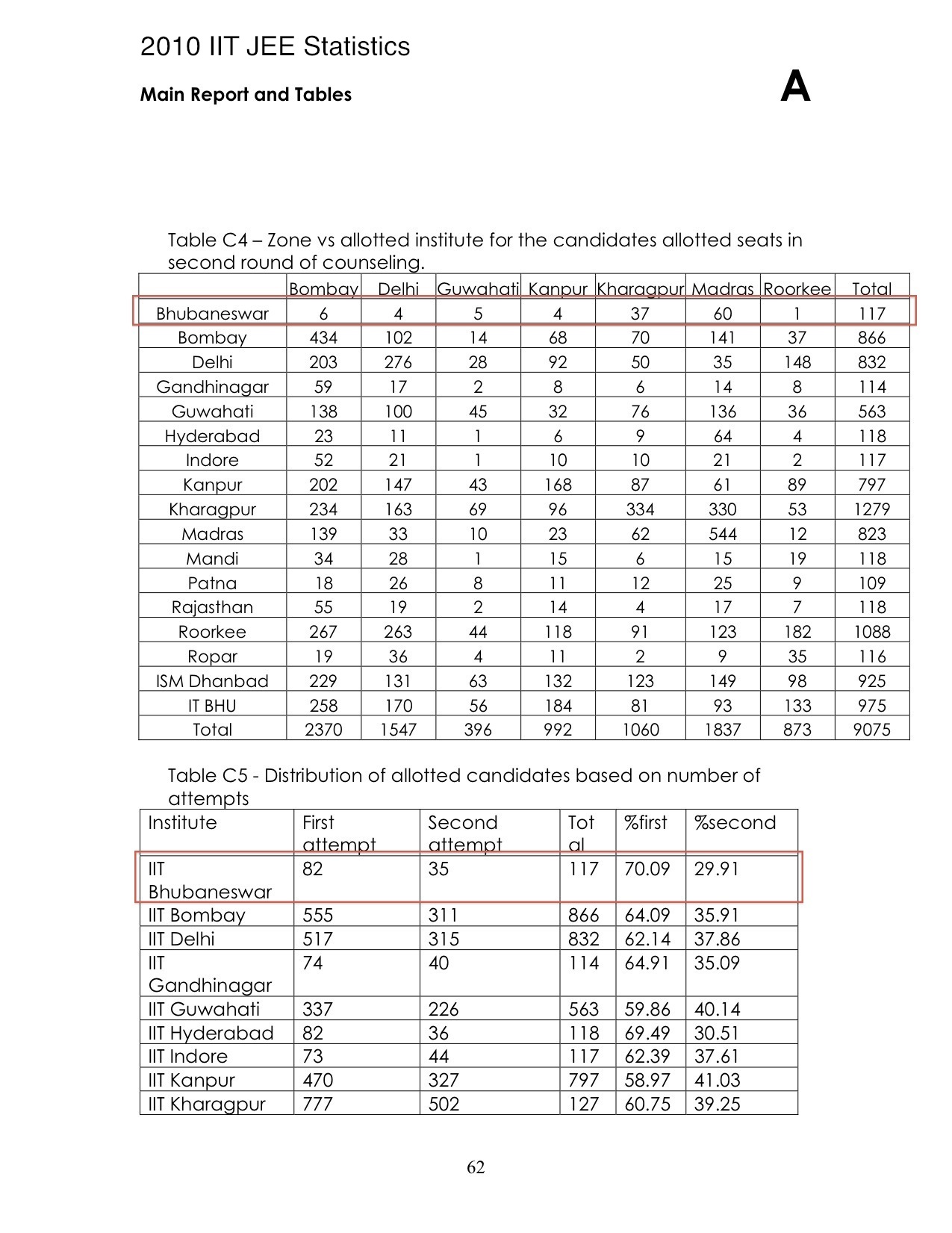
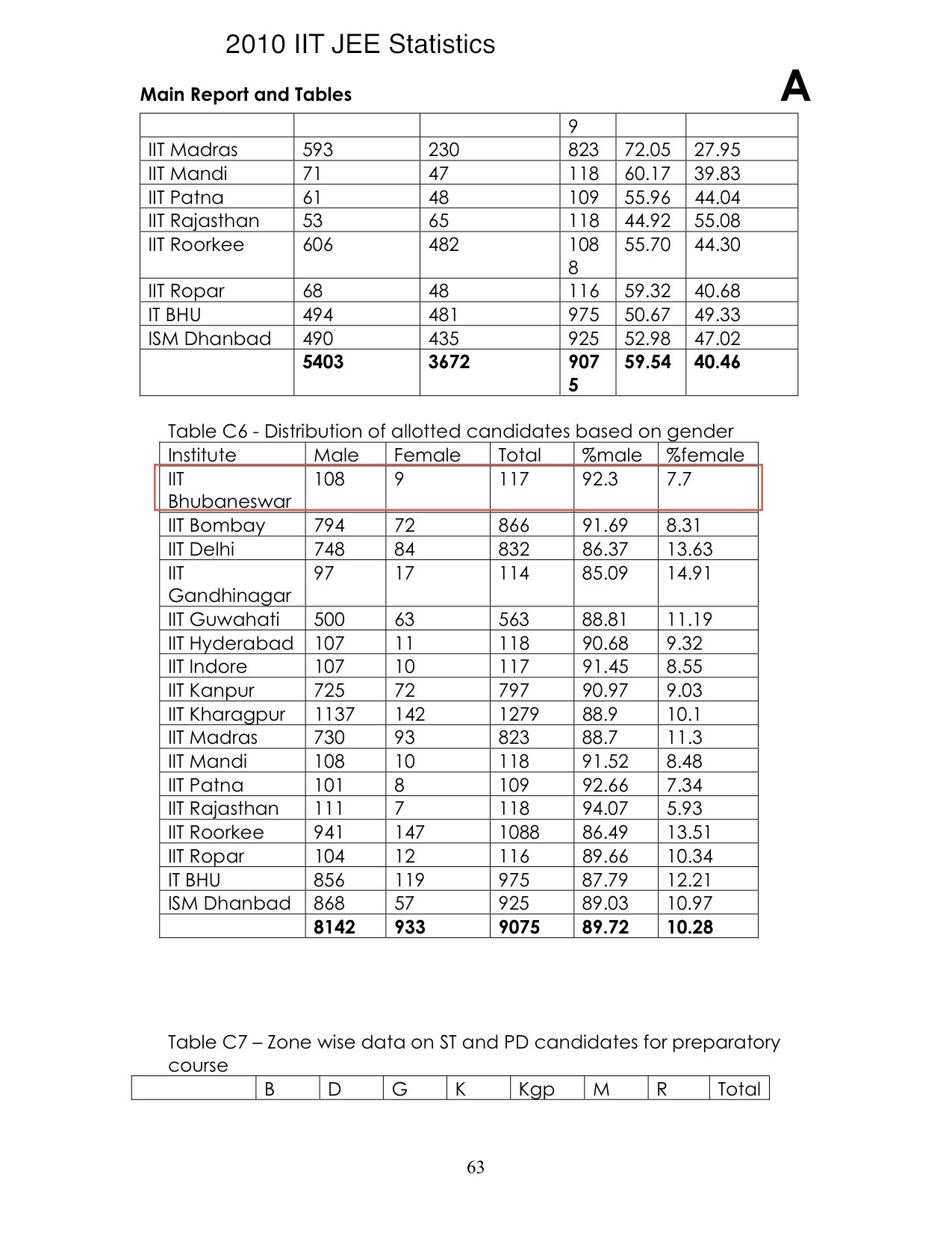
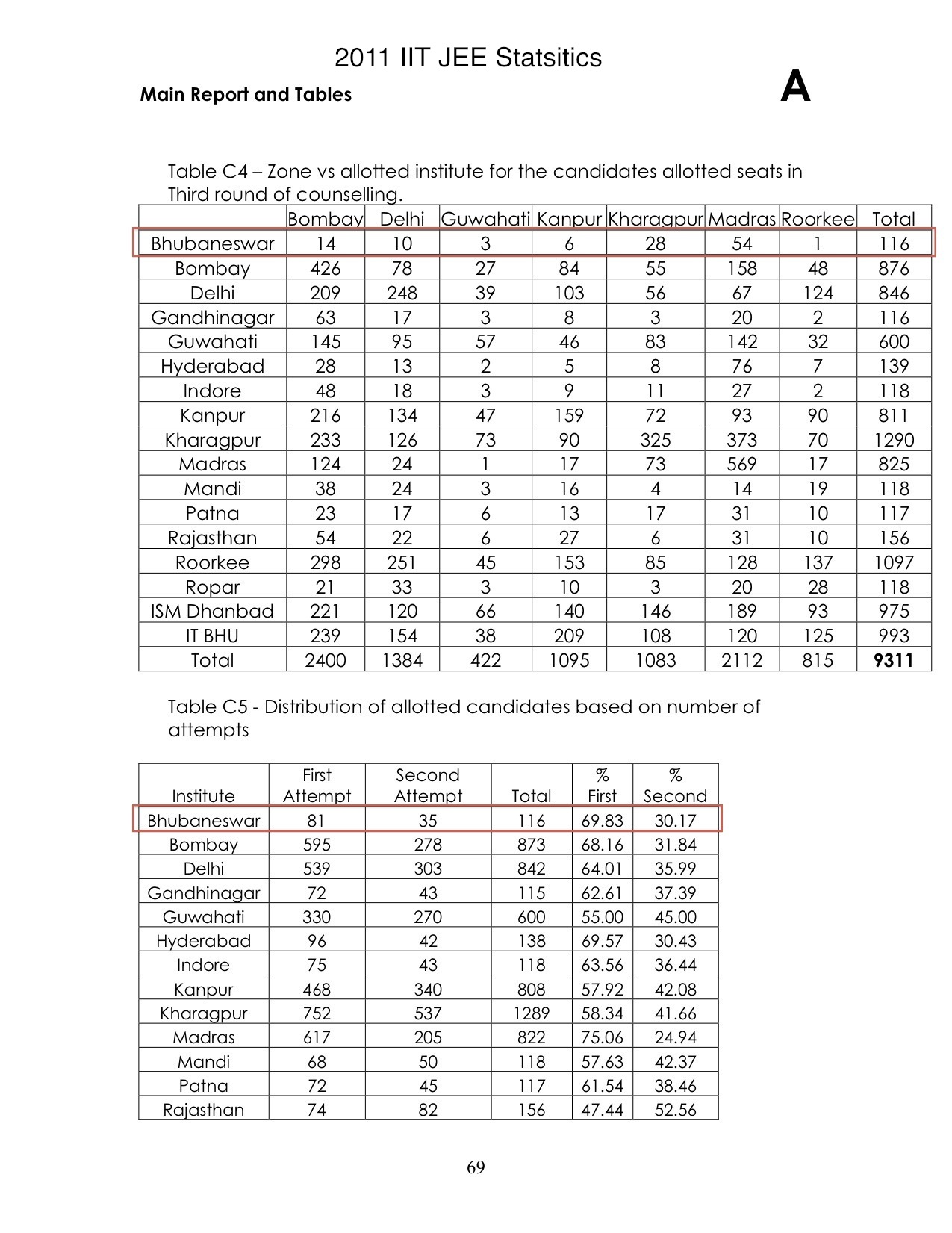
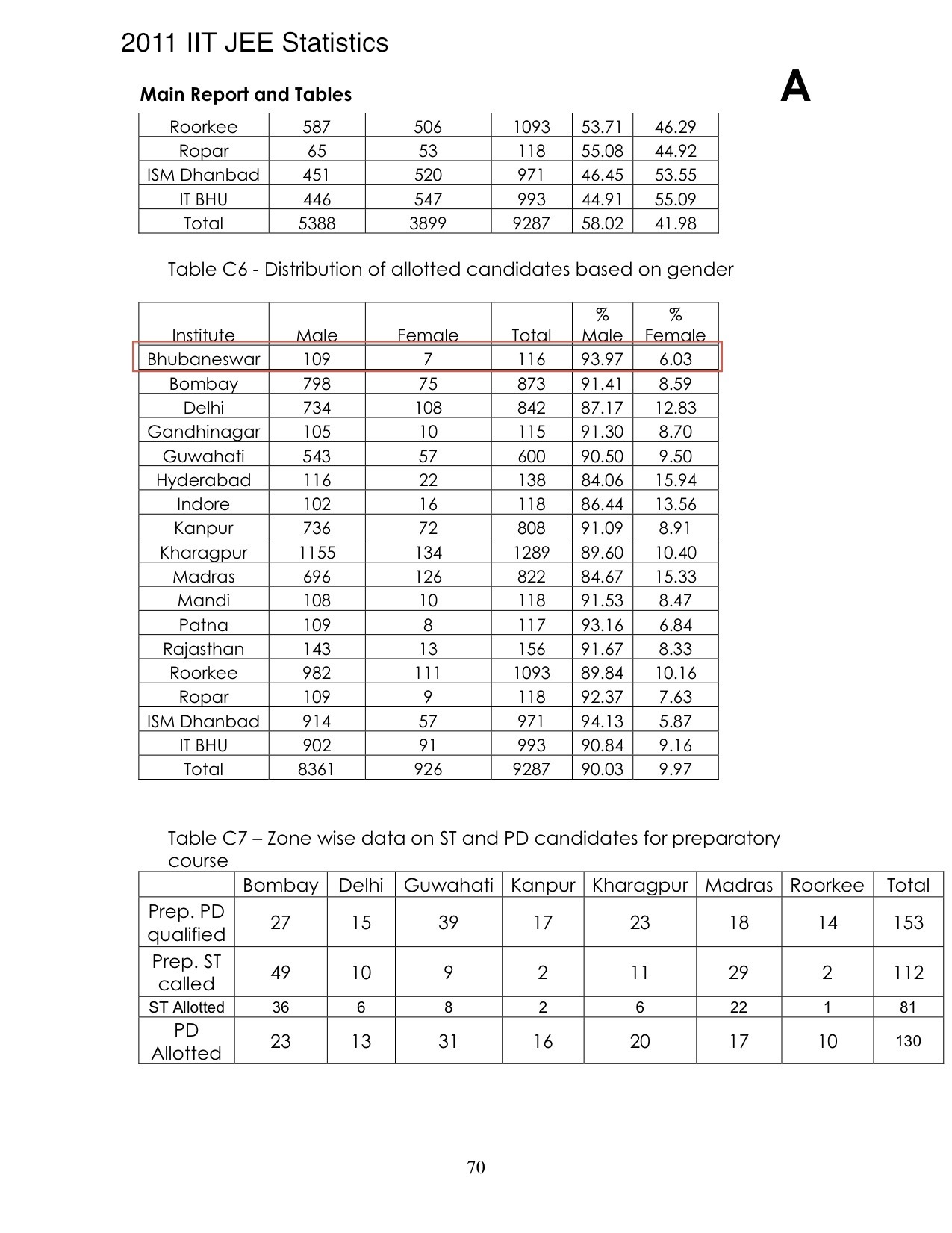
November 22nd, 2011
(Thanks to Abi for the pointer.) The following tables are from documents at http://www.iitsystem.ac.in/academics/admmission.jsp.




November 22nd, 2011
(Thanks to Abi for the pointer.) The following tables are from documents at http://www.iitsystem.ac.in/academics/admmission.jsp..jpg)
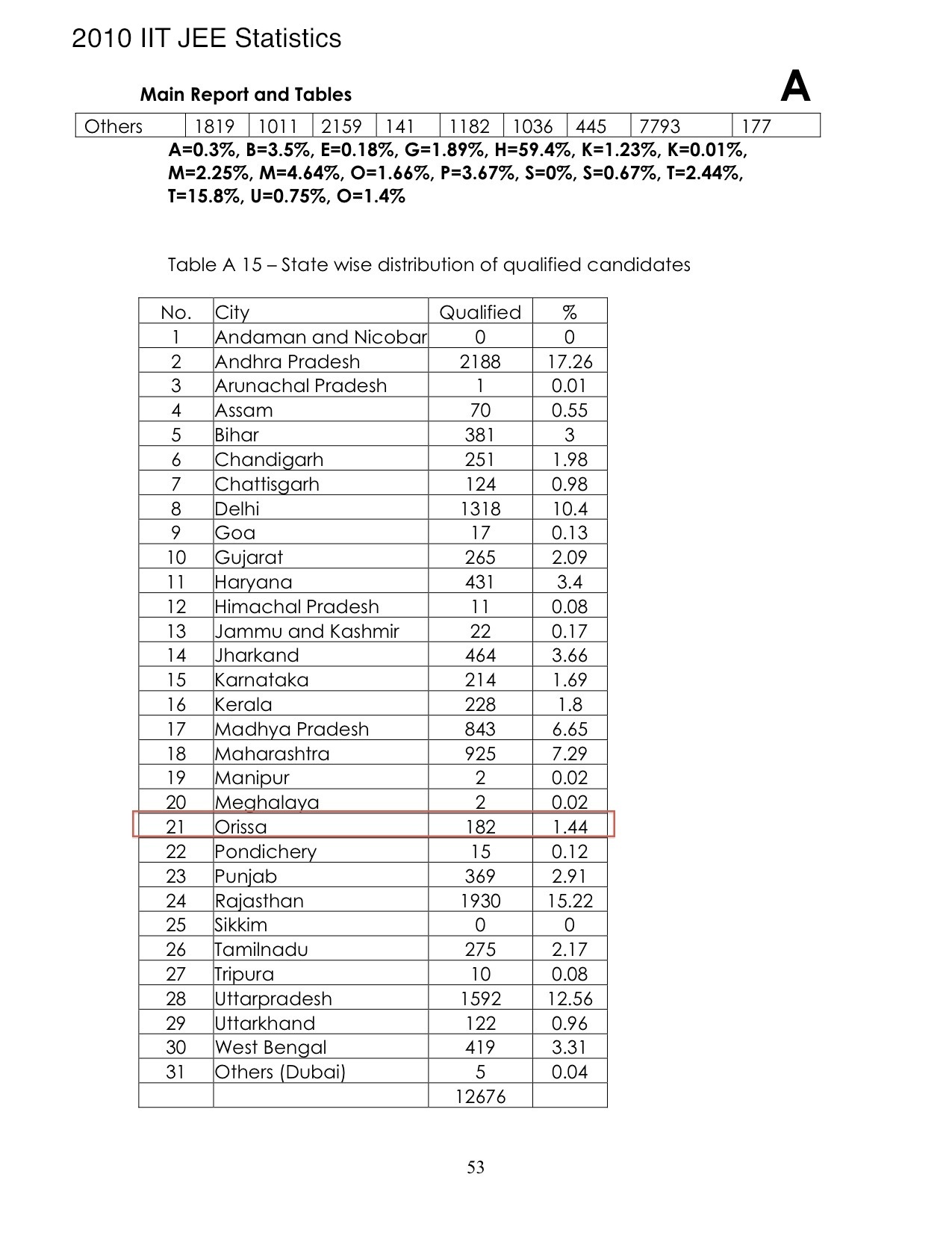
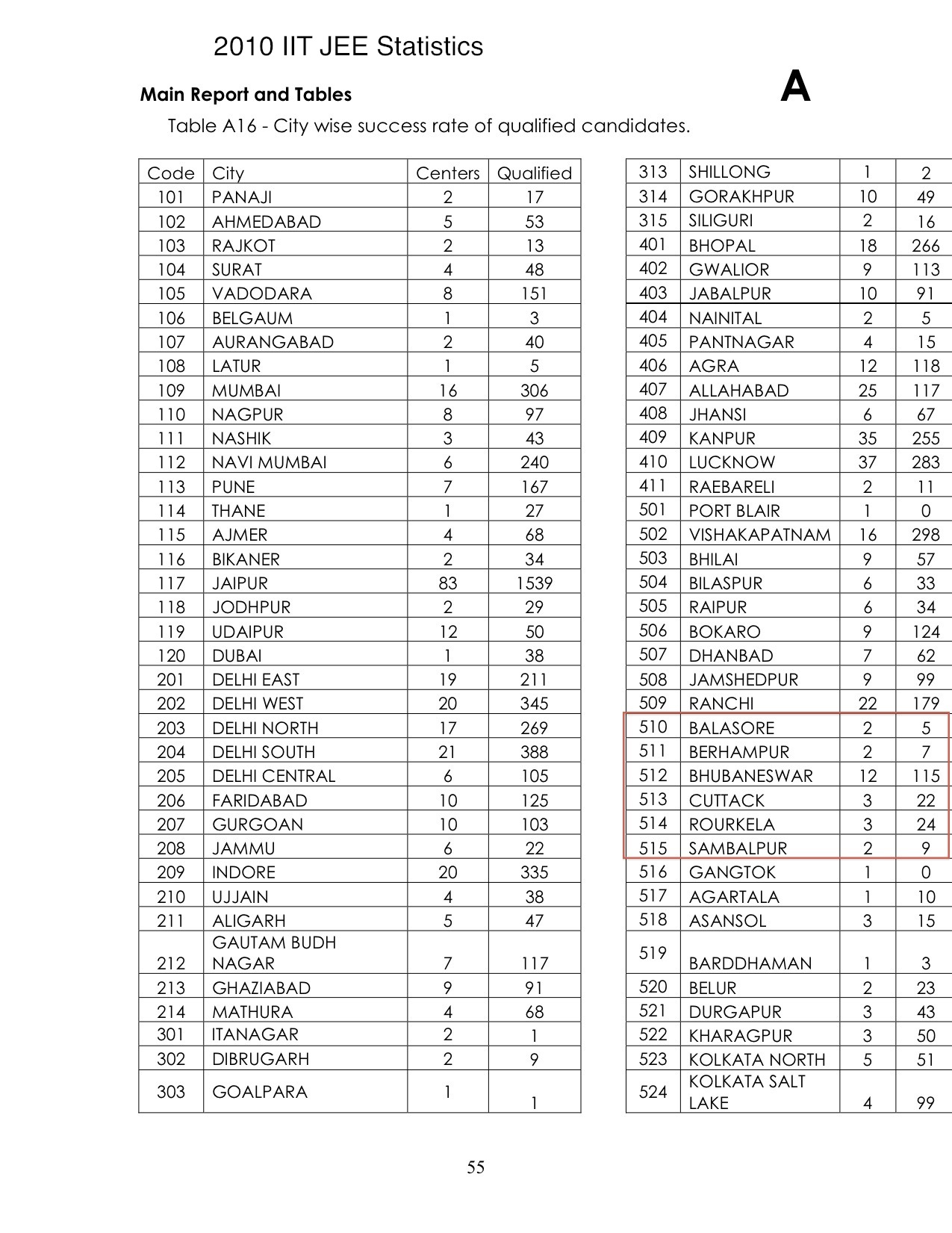
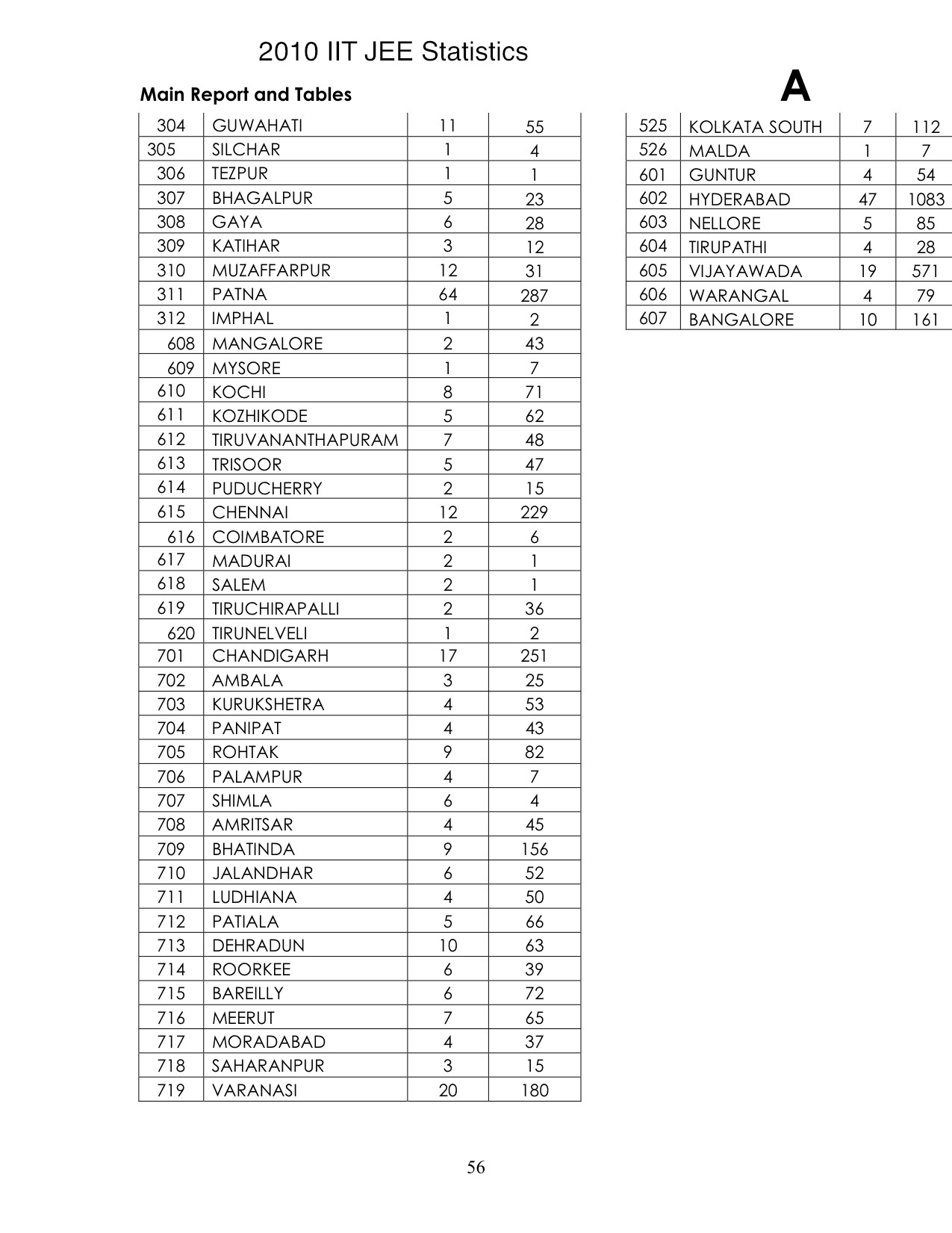
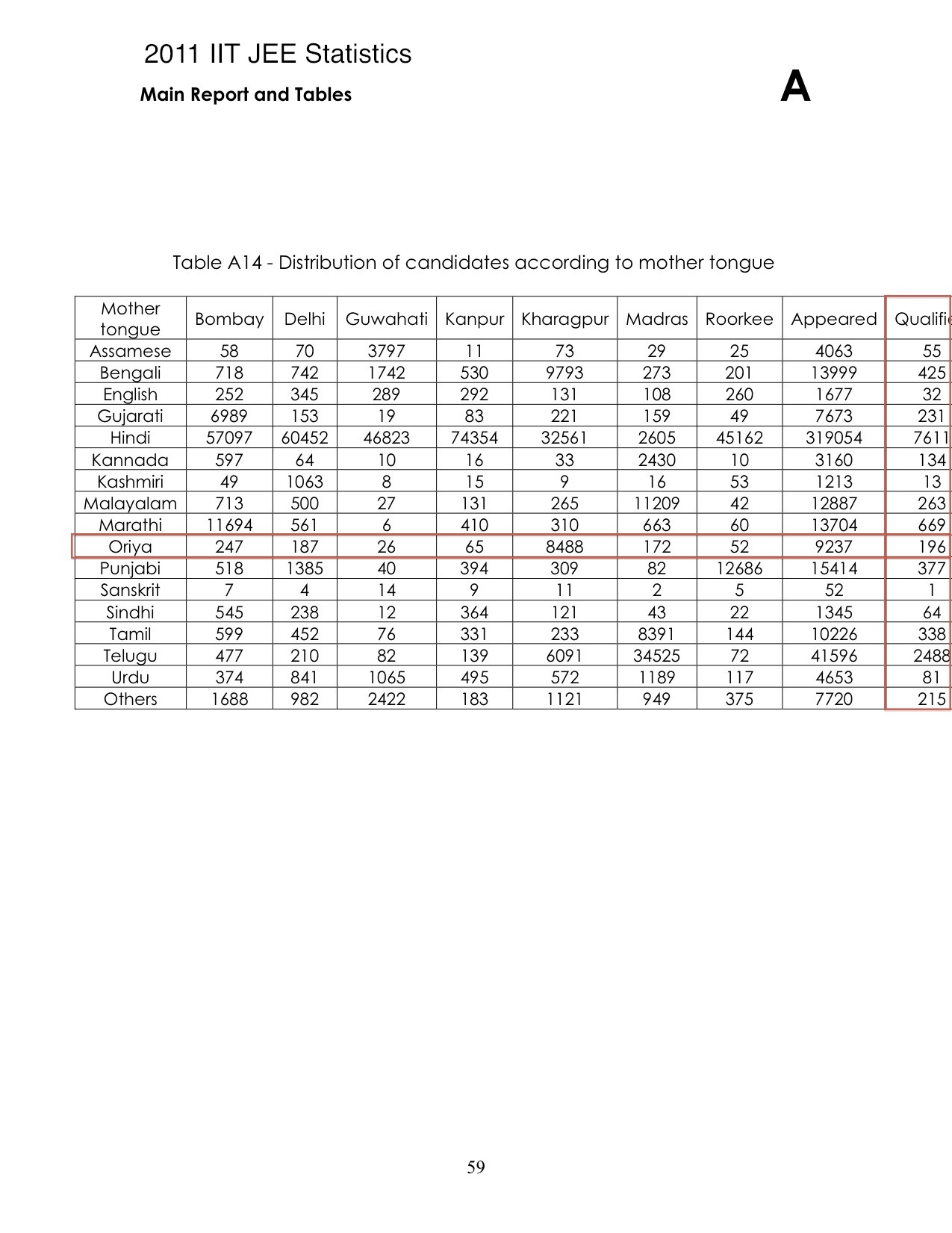
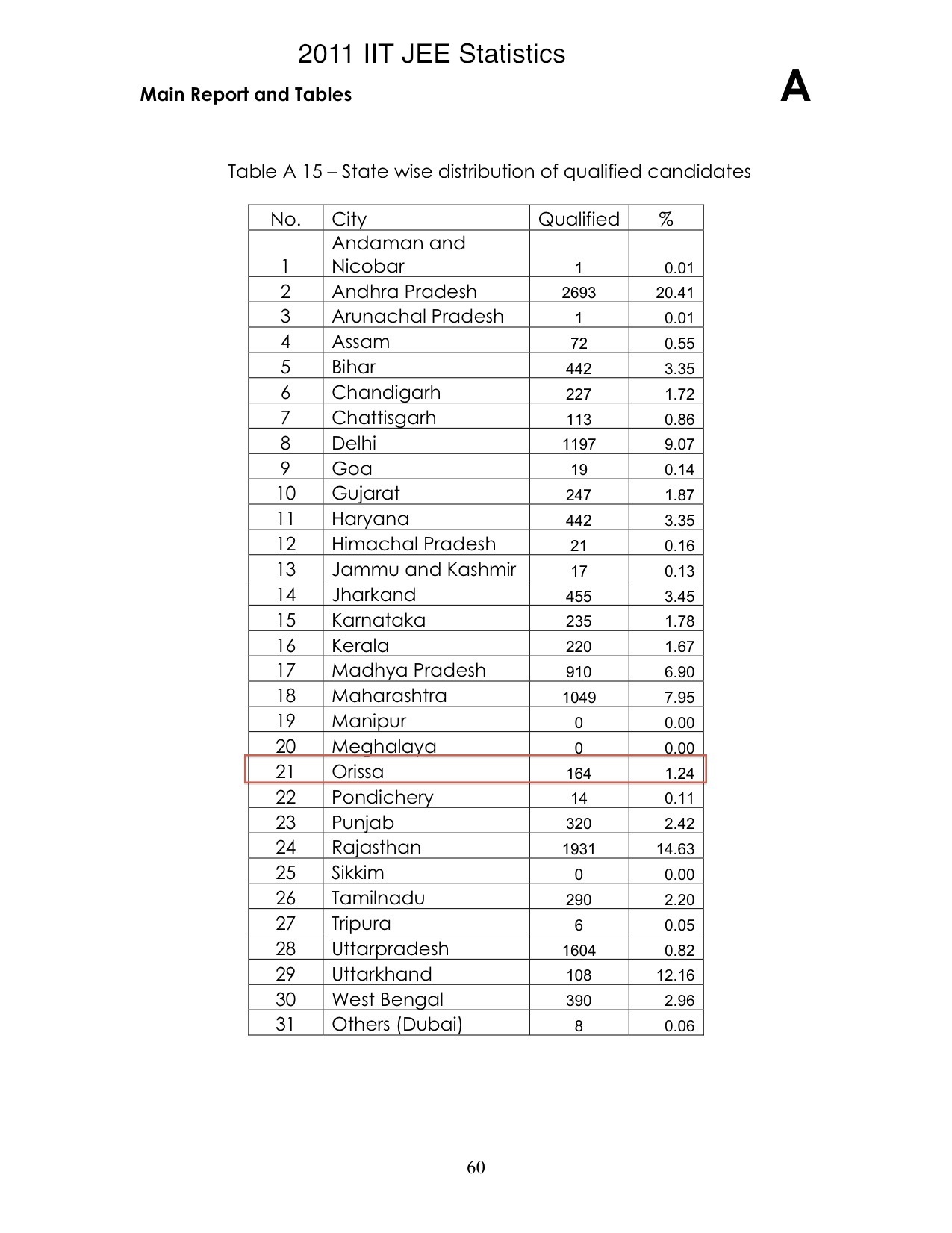
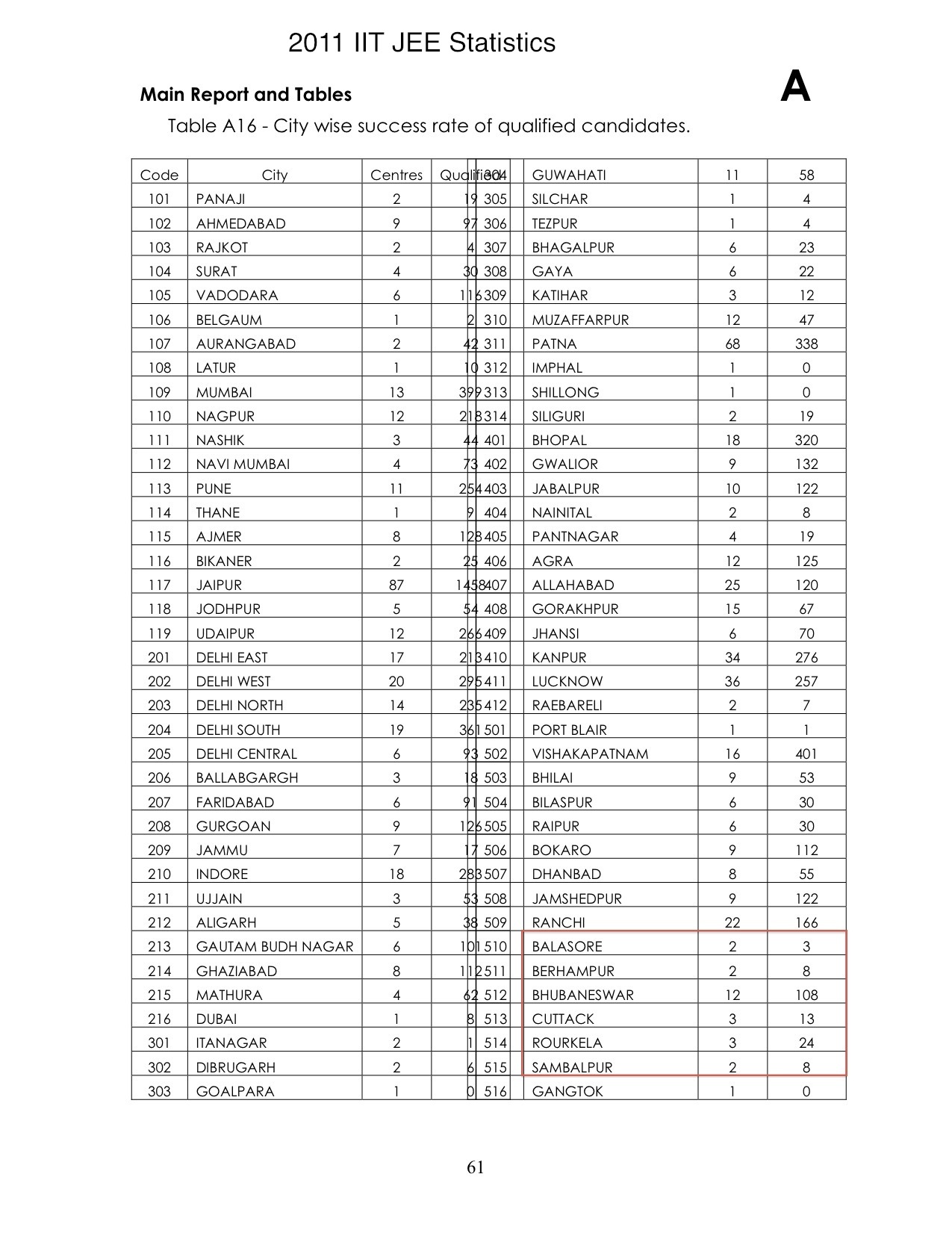
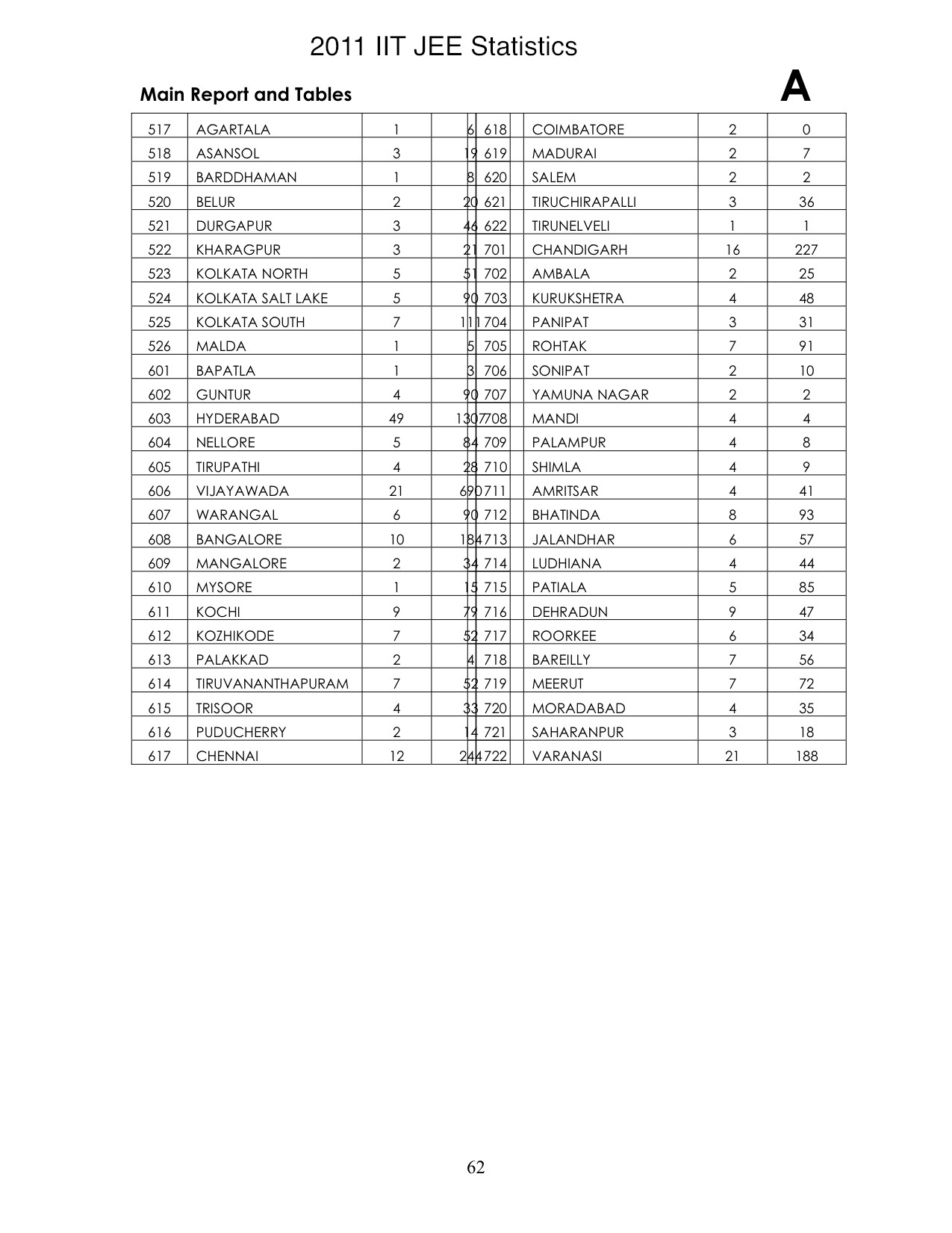
November 22nd, 2011
Following is an excerpt from a report in Telegraph.
The IIT Council today decided that subsidy on tuition fees for BTech courses should be given only to those students who pursue research and take up teaching jobs.
The council, chaired by human resource development minister Kapil Sibal, considered the report of the Anil Kakodkar committee which had suggested that operational costs for running the four-year courses should be covered by raising fees.
Students now pay Rs 50,000 as annual tuition fee. The operational cost per student comes to about Rs 2 lakh a year.
The council today decided that from 2013, students would have to pay the balance Rs 6 lakh if they take up a non-teaching job after graduation.
Scheduled Caste and Scheduled Tribe students, who do not have to pay any fees now, and students from poor families, who are on scholarship or have been granted interest subsidy loans, will, however, be exempt.
Students who study for MTech and PhD and take up teaching after that would not have to pay the Rs 6 lakh.
September 15th, 2011
Following is an excerpt from a report on Times of India regarding increase in the number of students appearing in IIT JEE from Odisha.
The number of IIT aspirants in Orissa saw a steady rise with nearly 40,000 students appearing for the joint entrance examination ( JEE) for the country’s premier institute on Sunday, officials said.
Registrar of IIT-Bhubaneswar Bata Kishore Ray said, "The number of aspirants from Orissa has gone up in the last couple of years, especially after IIT-B started operating from the city. …
… About 30,000 aspirants appeared from the state last year, he added.
… In the capital city alone, over 5,000 students appeared in 12 centres for one of the toughest competitive examinations in the country.
… Director of a city-based coaching centre Jyoti Ranjan Tripathy said good coaching facilities and number of successful students increasing every year has been motivating others to go for IIT. "In terms of coaching facilities, Bhubaneswar can be called the Kota of eastern India. Orissa has created some top rankers in IIT-JEE in the last few years and this has motivated more students."
As per a report in Economic Times, the total number of applicants for IIT JEE is 4,85,262.
Following is obtained from a Deccan Chronicle report, a TOI report and another TOI report:
* Two newspapers give different numbers.
Assuming the numbers for Odisha are correct, it is a significant development in that 8.25% of the total applicants will be from Odisha. Note that Odisha’s population is 3.47% of the total population of the country.
Ofcourse, a more important aspect is the success in the exam, but significant increase in the applications is a good starting point. Some of the reason behind this increase are:
Now lets hope a good number from Odisha succeed in IIT JEE. Currently Hyderabad and Kota are the places with the highest number of successful candidates. Following is an excerpt from a TOI report on that.
If JEE-2010 results are pored over, the maximum number of candidates to clear the exam was from Andhra Pradesh (AP).
The state dominated the merit list. Seven of the top ten rankers were from there, the share of Kota (which is in Rajasthan) starting only after rank 15. While in 2006, 938 candidates from AP and 1,004 from Rajasthan made it to the IITs, a year later the tables had turned, with 1,384 from AP clearing JEE and 1,344 from Rajasthan. It has been a close race since. In 2009, for example, 1,862 students from AP and 1,898 from Rajasthan cleared JEE.
There are reports from other cities and states, but many have contradictory reports. Following are data from some of these reports.
3 comments April 11th, 2011
(Thanks to Abi for the pointer.)
The web page for this program is http://www.iisc.ernet.in/ug/index.htm. Following are some excerpts from its main page.
The Indian Institute of Science, a leading institution of higher learning with a strong tradition of research for over a century, is opening its portals to undergraduate students by launching a four-year Bachelor of Science (BS) Programme. The programme is designed as a balanced blend of core science and interdisciplinary topics, to serve as a launching pad for research and doctoral studies in cutting-edge areas in science and technology. The graduates will also be ready for attractive career opportunities in academia and industry.
Major Disciplines offered: Biology, Chemistry, Environmental Science, Materials, Mathematics and Physics.
Students majoring in any of the above disciplines will also take courses in engineering, humanities, and inter-disciplinary areas for a well-rounded learning experience.
The inaugural batch will begin classes from August 2011 and graduate in July 2015.
Admissions will be based on national examinations such as KVPY and through other channels to be announced soon.
Eligibility: 12th Standard or equivalent with Physics, Chemistry, and Mathematics as main subject.
Applications will be accepted from January 1, 2011 till March 31, 2011.
August 19th, 2010
Prof. Jalote is the Director of IIIT Delhi and is on leave from IIT Delhi. Previously he taught at IIT Kanpur and University of Maryland. Prof. Singh is a professor at Auburn University, Alabama. Both are alumni of IITs. Following are excerpts from their article in Economic Times.
… The difficulty of cracking these tests have led to the booming coaching industry — it seems the vast majority of students appearing in these exams undergo some form of coaching for them. This impact of coaching has been decried by many. In academic circles, it is a common complain that coaching is allowing even average students to crack the exams, and how exams ought to be changed so that deserving students can clear even without coaching.
It should be clearly understood that the success of coaching is not due to the nature of the exams, but due to the low acceptance ratio in these exams. With these low accept rates, it is irrelevant whether the nature of exam is such that coaching will help or not.
… Anybody who thinks that coaching can be made redundant by reforming the admission tests is living in a state of denial.
There is another aspect of coaching that deserves attention. Coaching is big business: by some accounts, coaching for IITs is bigger than IITs themselves in terms of turnover. Consequently, it is able to attract good teachers by offering high salaries. One hears about IIT/IIM grads teaching in these coaching institutes, but one cannot come across an IIT/IIM graduate as a teacher in a school — even elite schools do not have this distinction. So, in many coaching centres, the quality of education is superior to that of schools, particularly with respect to the entrance test subjects. As the business success depends on how well they help the students do in the entrance exams, their teaching, as measured with respect to success in these exams, continues to improve and they take great care to improve it.
So, we have the following situation. Coaching institutes will continue to thrive as long as the accept ratio remains small. And coaching business will ensure that its teachers and teaching processes are well-equipped to impart training to students to do better at the competitive exam.
This situation, undesirable thought it is, can, however, be converted into an opportunity to improve education. As coaching institutes focus on the entrance tests and the syllabus for them, it provides a power to these exams in that whatever they put as syllabus or as expected knowledge, the coaching institutes will ensure that students get good at that. Even for those students who do not undergo coaching, these exams are highly influential — students learn/ study for these exams with a mission and dedication that they don’t show for anything else.
IF THESE large exams were to be oriented such that preparation for them will make the foundations for the key subjects much stronger and will force the students to really understand the subjects better, the coaching industry will ensure that this knowledge is imparted to students. That is, the syllabus and expectation is potentially a strong force on what students learn in the 2-3 years they prepare for the entrance exams, through coaching or on their own.
If this learning can be strengthened, then even if the students do not get through in these exams — which the vast majority will not — the preparation for them will give them strong foundations in some key subjects. This can be leveraged by other institutions.
… So, instead of fighting coaching by making exams like JEE harder and more theoretical every year, such large exams can leverage the competition for the larger good of improving the education and preparedness of students.
If these exams are thought of as a potential tool in the armory of the country for fighting the poor education standards, rather than just for admitting students into these institutes, then they can favourably impact the lakhs of students who attend JEE, and not just of the selected few thousands who actually enter the IITs, whose skills will be upgraded anyway to top levels by the top quality education that they will be provided. By doing so, institutions like the IITs and the entrance exams they have, will be making a solid contribution to improving the workforce in the country , as they have done in creating the top-level manpower.
I agree with the main point in the above mentioned article. Earlier I wrote my views on coaching at https://www.orissalinks.com/archives/4178.
However, there is an issue with respect to many students not being able to afford coaching. Couple of things that the governments may do are:
2 comments May 16th, 2010
Update: Following are excerpts from a follow-up Telegraph report which mentions about the committee’s recommendation to have wide-spread consultations before making the changes.
But it has advised caution in implementing the reforms. The panel has suggested detailed consultations and workshops with the state governments, other top engineering institutions like the National Institutes of Technology, and private universities.
The recommendations of the panel can be fine-tuned based on the outcome of the consultations, the team led by IIT Kharagpur director Damodar Acharya has suggested. The panel is likely to meet soon and may draw up a schedule for the consultations at that meeting.
… At a meeting of the panel in Chennai on March 16 with representatives of state and central school boards, some participants suggested that rural students be given more opportunities than urban students. The participants proposed two attempts for urban students and three for rural students.
The panel and the HRD ministry will also need to convince state governments that the move to end state-specific engineering tests is not against their interests.
Following is an excerpt from a report in Telegraph.
… The panel, appointed by human resource development minister Kapil Sibal, has recommended replacing the four-decade-old IIT-Joint Entrance Examination (JEE) and myriad other engineering entrance examinations with a common test modelled on the US-based scholastic aptitude test (SAT).
The panel has suggested that the IITs accord a 70 per cent weightage to board examination scores in picking students, ..
Scores in the common aptitude test that will replace the IIT-JEE will contribute the remaining 30 per cent weightage in determining which candidates are selected, the panel has recommended.
Unlike the current engineering entrance examinations including the IIT-JEE, the common aptitude test will not have questions on physics, chemistry and math, but will test students’ powers of logical reasoning and communication skills.
If the recommendations are accepted, the IITs will for the first time admit students based more on their board examination marks than on their performance in a special entrance test.
…The minister had announced in February that he was setting up a panel under IIT Kharagpur director Damodar Acharya to study proposed reforms to the IIT-JEE. The panel was appointed in March, with the directors of the IITs in Mumbai, Roorkee and Chennai as the other members.
… The panel has recommended that the government develop a Comprehensive Weighted Performance Index (CWPI) to calculate a student’s overall score based cumulatively on his performance in the board examinations and in the common aptitude test. The report appears principally based on discussions at a meeting held with other government representatives, including Central Board of Secondary Education chairman Vineet Joshi and select state representatives in Chennai on March 16.
The HRD ministry is already working towards a plan to introduce a common high school curriculum in the sciences and math, cutting across the 35 boards — central and state — that govern Indian school education.
The common curriculum would make easier a comparison between the board examination scores of students from schools affiliated to different central and state government boards, Joshi had told the meeting.
The CWPI proposed by the panel is aimed at normalising any differences that remain between difficulty levels of school-leaving examinations under different boards.
There is a big danger that the above approach will make the XIIth exams a high stakes affair and bring it under the microscope with every aspect of it being scrutinized and judged by everyone. Most coaching classes may reinvent themselves and start coaching how to score more marks in the XIIth exam and the proposed SAT type exam. This approach may bring in bias favoring students from families with educated parents. English being a compulsory subject in XIIth, this may put students in rural areas and other areas where English is less used at a disadvantage.
So one has to wait and see how this will pan out.
My guess is if the above idea is adopted, it will go through some changes such as specific types of colleges may be allowed to give different weight to Class XII marks in different subjects. Some may introduce interviews or other tests.
One change that should be made is that when possible specialty branches should not be assigned to most students (say 70-80% in any college/institute) immediately after they join a college/institute after the XIIth. That should be determined after a year in that college/institute based on the performance in that year. This will make the class XII exam less cutthroat and ensure that students after they get into a college/institute continue to give importance to academics.
One alternative idea may to test the proposed idea (of using class XIIth marks) on 50% of the seats for a few years before deciding whether to completely abandon the current approach or not.
7 comments April 14th, 2010
In https://www.orissalinks.com/archives/4059 we mentioned about some of the national tutorials that have now set shop in Bhubaneswar. A close friend and elder of mine (Sandip Dasverma) whom I respect a lot was surprised (and even dismayed) that I gave space to them here, and was wondering how come I am promoting institutes that to him are so harmful to our society.
I have mixed thoughts and feelings about the whole thing, so I decided I will write my thoughts and feelings, which at this point may not be fully coherent.
1. In Orissalinks we are writing about *all* kinds of educational and HRD infrastructure and opportunities in Odisha. When we write about ITI or Diploma or vocational schools we are not necessarily promoting them; nor it is our intention that every body should do ITI or a diploma. (On the other hand we do not think there is anything wrong in going to an ITI or doing a Diploma.) We cover them so that these pages serve as a dynamic directory of opportunities and infrastructure of various kinds. In that sense IIT tutorials are educational and HRD infrastructure elements and we cover them. Our coverage does not necessarily mean we promote them. In case of ITI and Diploma institutions, having them listed here helps industries who may be considering to move to Odisha.
2. To us IIT tutorials are HRD infrastructure elements that for whatever reason are an important component of a city/town/metro/population-hub. Students are looking for them, the parents are looking for them, the top ones at other locations have been successful in sending large numbers to the IITs, and parents in Odisha due to the lack of such institutes have sent their kids out of state. Moreover, Odisha has been sending comparatively very few students to IITs, thus not taking advantage of the opportunity provided by the well-funded and reputed IITs. So in that sense having top national coaching classes in Odisha is good. The kids who want to go there need not now go to or be sent to (by their parents) locations out of state and hopefully there will be more number of people getting to IITs from Odisha because of the presence of these nationally reputed tutorials in Odisha.
Hopefully we have clarified why we covered IIT tutorials here; We covered them because as the situation in India is now, they are an important educational infrastructure of a place/town/city/metro.
Thats that, but what do we think about these tutorials and their alleged harmful impact on the education system and society. To us the issue is not so simple nor black and white. To initiate a debate we will put some pointers and arguments.
I hope the above thoughts explain why I don’t agree with the crowd and follow the fashion these days among many who put all the blame in the world at the door of coaching classes. I can see some adverse results (such as the story about an IIT JEE number 1 who was coached three years before he got JEE 1 but flunked in many of his classes in the first year) but it is not easy for me to just point blank think coaching classes as evils. In fact there may be evidence to the contrary. The coaching classes seems to have helped students from far flung areas without access to good schools to get trained and get into the IITs. The success of the super 30 in Bihar has now prompted the Punjab government to start similar coaching for rural students in Punjab. Similar plans are also afoot in Tamil Nadu and Chhatisgarh. The Orissa government had also announced similar plans in collaboration with the Institute of Mathematics & Applications. I am not sure if that has been implemented.
Now some other related thoughts.
Having said all this, what would be my advice to students in their 11th and 12th grade?
8 comments April 3rd, 2010
The following is extracted from http://jee.iitd.ac.in/openclose09.htm.
| Institute | Open EE (11) | Close EE (11) | Open ME (24) | Close ME (24) | Last rank |
| IIT Bombay (B) | 8 | 109 | 72 | 494 | 3884 (Chemistry) |
| IIT Delhi (D) | 108 | 241 | 237 | 634 | 2981 (Biochem & Biotech) |
| IIT Madras (M) | 32 | 310 | 275 | 820 | 3500 (Biotechnology) |
| IIT Kanpur (K) | 39 | 416 | 497 | 806 | 4684 (Chemistry) |
| IIT Kharagpur (G) | 596 | 920 | 830 | 1191 | 6327 (Architecture) |
| IIT Roorkee (R) | 848 | 1821 | 927 | 1909 | 5467 (Chemistry) |
| IIT Guwahati (W) | W16-2043 | W-16 2489 | 1693 | 2608 | 5748 (Design) |
| IIT Hyderabad (H) | 985 | 2645 | 1812 | 2876 | 2876 (Mech) |
| IIT Gandhinagar (N) | 1939 | 3038 | 1736 | 3317 | 3741 (Chemical Engg) |
| IIT Rajasthan (J) | 2830 | 3555 | 2947 | 3792 | 3792 (Mech) |
| IIT Bhubaneswar (A) | 2585 | 3704 | 3147 | 4025 | 4272 (Civil) |
| IIT Indore (E) | 2502 | 3916 | 3133 | 4060 | 4060 (Mech) |
| IIT Punjab (U) | 3293 | 3847 | 3336 | 4001 | 4001 (Mech) |
| IIT Mandi (C) | 3547 | 4146 | 3185 | 4288 | 4288 (Mech) |
| IIT Patna (P) | 3439 | 4313 | 4097 | 4410 | 4410 (Mech) |
| IT BHU (V) | 2073 | 3782 | 2389 | 4014 | 7117 (Pharmaceutics) |
| ISMU Dhanbad (S) | 4229 | 5611 | 4571 | 5680 |
7063 (Chemistry) |
(The 2008 open-close ranks are here.)
July 14th, 2009
I had heard that many of the Kota coaching institutes hire IIT graduates to teach, but did not know how much they paid. The following excerpt from an Indian Express report mentions that even high schools in Delhi hire IIT graduates to coach their students.
Not only did 30 of its students make it to the IITs, Modern Vidya Niketan, Faridabad, has also produced the all-India IIT-JEE topper, Nitin Jain. Nearly 430 students appeared for the examination and 141 were able to make it to the merit list. In 2008 too, the school had an impressive number of students cracking the IIT-JEE, but this year’s results surpassed all expectations, managing director Varun Sharma said. “For the last 15 years, we have been sending students to the IITs. At least 15 have made it every year,” he said. The school employs around 25 former IITians and pays them a package of up to Rs 15 lakh per annum each, according to Sharma.
1 comment May 29th, 2009
Following is an excerpt from a report in expressbuzz.com.
A preliminary estimate puts the number of successful candidates from the State at about 200 – including those who secured All India Ranks (AIR) and those who figured in the extended merit list announced on Monday.
While 150 students are believed to have cleared the test from Bhubaneswar alone, 11 students of Jawahar Navodaya Vidyalaya, Mundali, in Cuttack notched up good ranks.
Initial reports said approximately 10 students from Berhampur and another 20 from Rourkela made it to the extended merit list.
This IIT success rate is probably the best ever in the State with one student, …
JNV, Mundali, where about 39 students were given special coaching for IIT, saw its student Abhisek Rai getting AIR 1,948 (placed 258th in OBC category list).
Another student, Pratapbandhu Solanki, has secured 12th rank in Scheduled Tribe (ST) category, whereas Sourav Ginnore got 232nd rank in Scheduled Caste category.
Similarly, Ravindra Chourase (324), Saroj Nayak (437), Ranu Choudhury (543), Rakesh Malick (692), Soumya Ranjan Sahoo (731), Nitesh Patra (831) and Kamlesh Ahirwar (953) are among the successful candidates in the SC list, school principal S B Rao said.
The private IIT tutorial institutions were ecstatic about the results. Akash Institute claimed at least 91 of its students cleared the all-India entrance.
Director A B Singh said 24 of its students were on the merit list, while the rest were on extended list.
Similarly, Vidwan claimed 56 students followed by Naidu with 11 and Kalinga Bharati with about 20 students.
… From Kharagpur zone, of 52,176 students, only 928 students qualified. The result percentage in Kharagpur zone is below 2 per cent.
3 comments May 26th, 2009
Orissatv.com reports in http://orissatv.com/NewsDetail.asp?newsId=NS3601 that 300 Orissa students cracked the IIT entrance. If that means they qualify for the IIT then it is a great improvement over previous years. If the 300 includes the exttended merit list then one needs the data regarding how many are in the EML and how many qualified for the IITs. If even half of the 300 qualified for IIT then also it is an improvement over the previous years. The article goes on to say:
The state students performed well only after the establishment of an IIT in Bhubaneswar recently.
However, Orissa is still far behind other states. For example, 2000+ qualified from Andhra Pradesh. Comparable to Orissa is Gujarat from where 167 qualified to the IITs and 175 are in the extended merit list.
Update: Dharitri says 700 qualified from Orissa.
May 26th, 2009
2 comments May 14th, 2009
(Thanks to Jagmohan Swain for suggesting to write about this.)
See the data at https://www.orissalinks.com/archives/1303.
Aggregate Total for every 500th rank in Common Merit List
|
Rank in Common Merit List
|
Aggregate Marks
|
|
1
|
433
|
|
501
|
287
|
|
1001
|
263
|
|
1501
|
248
|
|
2001
|
236
|
|
2501
|
227
|
|
3001
|
219
|
|
3501
|
212
|
|
4001
|
206
|
|
4501
|
200
|
|
5001
|
195
|
|
5501
|
191
|
|
6001
|
186
|
|
6501
|
182
|
|
7001
|
179
|
|
7501
|
175
|
|
7903
|
172
|
Also, from http://www.hellogiri.com/iit-jee-2008-cutoff-marks-details/ we have the following:
… first paper of IIT JEE 2008 consisted of 69 objective question with 246 marks. Second paper was also of same marks. So the full marks of IIT-JEE 2008 examination was 492. All questions were of objective type with negative marking. The duration of each paper was three hour.
… For OBC quota cutoff will be around 170 marks for rank 4000.
Based on the above and the open-close numbers given at https://www.orissalinks.com/archives/1303 one can see that one can get into an IIT by scoring 45% in the IIT JEE.
March 1st, 2009

The eligibility criteria has been made to discourage multi-year preparation for IIT JEE. To be eligible for IIT JEE 2009 students must NOT have passed their qualifying exam before Oct 1, 2007 and must not have taken admission to an IIT/IT-BHU/ISMU in the past by paying full fees. They must also have secured at least 60% in their qualifying exam. See details at the IIT JEE 2009 sites such as at IIT Guwahati.
3 comments November 10th, 2008
| M | T | W | T | F | S | S |
|---|---|---|---|---|---|---|
| 1 | 2 | 3 | 4 | 5 | 6 | |
| 7 | 8 | 9 | 10 | 11 | 12 | 13 |
| 14 | 15 | 16 | 17 | 18 | 19 | 20 |
| 21 | 22 | 23 | 24 | 25 | 26 | 27 |
| 28 | 29 | 30 | ||||